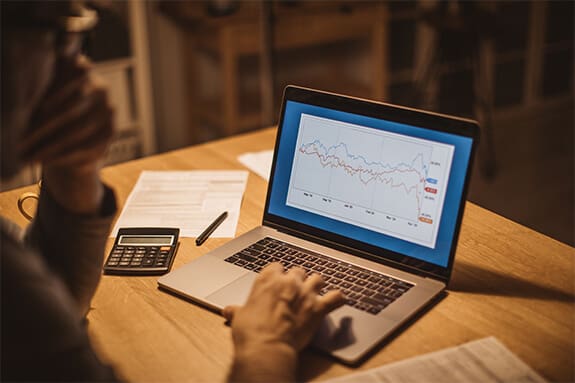Economies are always changing. Usually, they grow, and when they do, a low level of inflation — in other words, slightly rising prices — is considered healthy by economists. Some inflation is believed to spur economic growth, which is why many central banks and governments try to manage monetary policy to produce a long-term inflation rate of around 2% per year. But sometimes, albeit rarely, inflation occurs when economic growth has flatlined, or has even turned down. That rare phenomenon is called stagflation, which is always bad. Stagflation can create major economic problems and is difficult to overcome.
Key Takeaways
- Inflation is the rate at which overall prices are rising and the “real value” of money is falling.
- A low and steady inflation rate is considered a sign of a healthy, growing economy.
- Stagflation occurs when prices continue to rise while growth slows or turns negative.
- Stagflation can be difficult to recover from, as policies that curb inflation can also curb growth, compounding the problem.
What Is Inflation?
Simply put, inflation refers to a rise in prices across an economy. In the U.S., inflation is usually measured by the Bureau of Labor Statistics’ Consumer Price Index (CPI) as the key inflation indicator, which compares the year-to-year price changes of a “basket” of goods and services, weighted by their relative importance to the economy. Because the price of one good can fluctuate due to noninflationary causes, like a brief industry-specific supply shortage, looking at such a broad basket of goods paints an expanded picture of prices across the entire economy. The price of bread may rise steeply due to seasonal climatic conditions, but if the price of other goods remains the same, bread alone will have little impact on the basket and the overall inflation rate will remain low. Inflation that tops 50% is considered hyperinflation, which usually requires a major currency overhaul to fix.
Inflation has many possible causes, which usually fall into one of three categories: demand-pull, cost-push or built-in. Demand-pull inflation occurs when demand rises due to an increased money supply, commonly from falling interest rates, higher government spending or tax cuts. Demand-pull inflation can be kept in check if businesses step up production to meet that increased demand, thus stabilizing prices. But if the economy is “overheated” and operating close to peak efficiency, prices may continue to rise until interest rates or taxes rise, both of which tend to reduce consumer spending/demand.
Cost-push inflation happens when there is a drop in supply because of rising production costs. Those costs could be driven up by increased wages or higher prices for raw materials. For many goods, higher prices cause lower demand, so cost-push inflation often dissipates rapidly as the market naturally reaches a new balance. But for goods with fairly inelastic demand, like gasoline, price inflation may continue to rise. That leaves people and businesses with less to spend in the rest of the economy, which can cause an economic recession that brings higher unemployment and business failures for organizations that haven’t taken proactive steps to survive a recession.
Built-in inflation is synonymous with “wage-price spiral”. Expectations are at the root of built-in inflation — people and businesses expect high inflation, and that expectation influences their behavior. In a wage-price spiral, wages increase without a corresponding increase in productivity, forcing businesses to raise prices. Workers then demand higher wages to cover the rising costs, and a positive feedback loop is created. Built-in inflation can be more difficult to slow than other types of inflation and is considered more dangerous because it can lead to hyperinflation if the spiral gets out of control. It can also lead to higher unemployment.
What Is Stagflation?
Stagflation, as the word implies, combines “stagnation” and “inflation” — and it means exactly that. Stagflation happens when prices are increasing but the overall economy is stagnating or, worse, actually shrinking. Stagflationary periods show low, zero or negative growth, as measured by gross domestic product (GDP), which the U.S. experienced in the mid-1970s. In the early 1970s, government policies created near-full employment and strong growth, but the oil supply shock of 1973 drove inflation to double digits as the high price of oil rippled through the U.S. economy and led to a deep recession, though recession and stagflation are not the same. Such stagflation causes misery for consumers, because rising prices mean their money buys less and less, but high unemployment means their wages can’t rise to compensate. So, their real cost of living goes up, often leading to empty savings.
Stagflation is triggered by one or both of two factors: a shock to supply and/or a failure of economic policies. A supply-side shock happens when the price of a widely used commodity, like oil, shoots up, increasing costs. In the 1970s, the energy crisis and oil embargo forced oil prices to rise, raising costs throughout the economy. When prices rise, businesses often lower wages or shrink their workforces, then pass on higher prices to buyers. Frequently, those inflationary effects stabilize and prices return to previous levels when the supply chain gets restored. However, these effects may take months or years to fully return to their pre-shock levels.
Stagflation can also be caused by monetary and fiscal policy from governments or central banks that is misaligned with current economic conditions. A sharp rise in costs for businesses, like a large tax increase, could generate a price hike without an accompanying rise in productivity or output, especially if the economy is running close to capacity. Additionally, if interest rates are kept too low for too long, supply may not be able to keep up with the rise in demand that comes from “cheap” money, and prices could continue to rise even with economic productivity stalled.
Inflation vs. Stagflation: Key Differences
Since stagflation is a specific type of inflation, it can be tricky determining the point at which inflation becomes stagflation. Stagflation always comes with inflation, but inflation can, and usually does, happen without stagflation. They both have rising prices and, if left unchecked, can hurt an economy. But stagflation comes with deeper problems and can potentially cause more damage to an economy, and it’s harder to recover from.
The way employment behaves during inflation and stagflation marks a crucial difference between the two — and is, therefore, a real, telltale sign for when inflation becomes stagflation. Economist A.W. Phillips’s famous Phillips curve models an inverse relationship between the inflation rate and the unemployment rate — as one goes up, the other goes down. But during the stagflation of the 1970s, the U.S. economy experienced high inflation and high unemployment at the same time. High inflation came from the oil-supply shock, which also caused a recession; and the recession, in turn, drove unemployment higher.
Fixing stagflation is also more challenging than fixing inflation, though businesses have opportunities to beat stagflation individually. Policy actions that lower inflation, like raising interest rates, also tend to lower economic growth. So, when high inflation and poor growth occur together, it’s a challenge for policymakers because just about anything they do will worsen one of those phenomena.
The accompanying chart outlines the key differences between inflation and stagnation.
Key Differences Between Inflation and Stagflation
| Inflation | Stagflation | |
|---|---|---|
| Definition | Inflation occurs when prices rise across an economy. It is often described as “too much money chasing too few goods”, and it generally happens during periods of economic growth. | Stagflation is a period of quickly rising prices but with simultaneously low or negative economic growth and high unemployment. The inflation often outpaces growth. |
| Potential Causes | Inflation can be caused by a rise in aggregate demand or rising production costs that spur a drop in supply. A wage-price spiral can also cause inflation. | The two most common causes of stagflation are supply shocks in commodities, like oil, that affect the entire economy, and inappropriate monetary and/or fiscal policy. |
| Frequency | Inflation is common and can be a sign of a healthy economy. In the U.S., positive inflation has occurred in all but three years since 1940. | Stagflation is rare. In the U.S., the last stagflationary period was in the 1970s. |
| Duration | Inflation is measured on a year-to-year basis and varies. Extended periods of inflation above 5% are not common in the modern U.S. economy, but last occurred from 1973 to 1982. | Stagflation is often long-lasting. The U.S. stagflation of the 1970s, which some economists believe started in the 1960s, did not end until the early 1980s. |
| Effect on GDP | Inflation tends to lead to short-term increases in GDP, as consumers often spend more when they are worried that prices will rise in the future. Long-term high inflation can cause a decrease in GDP because high prices can squeeze out customers and investors. | GDP growth is often low or negative during periods of stagflation. |
| Employment | Inflation and unemployment usually have an inverse relationship, as demonstrated by the Phillips curve. High inflation tends to appear alongside low unemployment, and vice versa. | High unemployment is present, together with high inflation, during stagflation. The U.S. unemployment rate was above 7% for much of the decade between 1974 and 1986. |
| Recovery | Periods of high inflation can end when money supply and consumer demand are reduced through monetary policies like higher interest rates, higher taxes and reduced government spending. Fixing a broken supply chain can also curb inflation. | Stagflation recovery can be long and difficult because investing in economic growth can compound inflation and raising interest rates to lower inflation generally results in slower economic growth. |
Conclusion
Low inflation is typically a sign of a healthy economy, as it can spur investments and growth and keep interest rates low. Too much inflation, however, can create problems for businesses and consumers as the economy overheats and standards of living decline in tandem with skyrocketing prices. NetSuite provides the right level of visibility into financial and operating data to help business leaders truly understand current results, as well as to develop what-if scenarios and forecasts.
When coupled with low or negative growth, high inflation turns into stagflation. Periods of stagflation are rare and combine high inflation with high unemployment, which don’t normally occur together. Stagflation can deplete people’s savings and businesses’ cash and lead to entrenched economic problems that are difficult to overcome. Governments and central banks watch for the warning signs of stagflation, so they can prevent it from gaining a foothold.
#1 Cloud
Planning Software
Stagflation vs. Inflation FAQs
Are hyperinflation and stagflation the same?
Hyperinflation occurs when inflation tops 50%, most notably seen in 1920s Germany. Stagflation is inflation coupled with stagnant economic growth. While inflation may be high during periods of stagflation, it hasn’t been known to reach the level of hyperinflation.
What are the 3 types of inflation?
The three types of inflation are demand-pull, cost-push and built-in. Demand-pull inflation happens when an increased money supply causes demand to rise faster than supply. Cost-push occurs when supply shocks cause prices to rise. Built-in inflation is also called a wage-price spiral, because wages and prices both rise to compensate for the other, creating a positive feedback loop.
Does inflation increase during stagflation?
Inflation tends to remain high during stagflation. During the recovery period, as policymakers try to shift an economy out of negative growth, investments in the economy can prompt inflation to climb even higher and to persist beyond the end of the stagflationary period.
What is the difference between stagflation and recession?
Recessions are a regular part of economic cycles. They are shrinking periods that generally follow extended periods of growth. High inflation is not a common aspect of recessions. However, during periods of stagflation, low growth is coupled with high inflation and can cause problems that are difficult to overcome.









